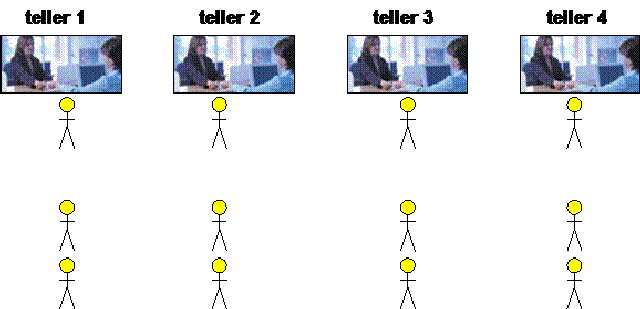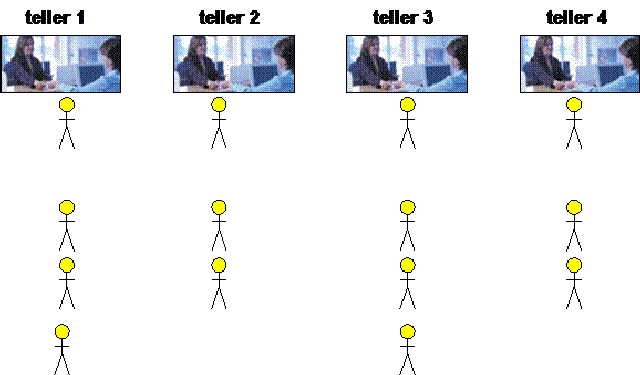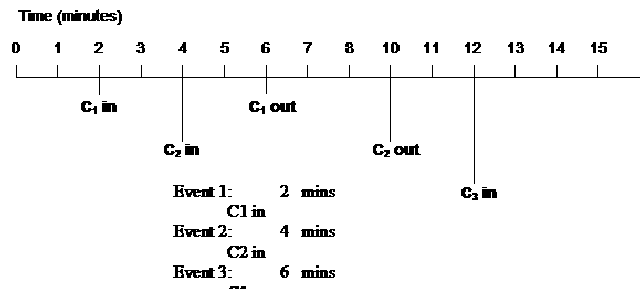Out of the numerous uses of the queues, one of the most useful is simulation. A simulation program attempts to model a real-world phenomenon. Many popular video games are simulations, e.g., SimCity, Flight Simulator etc. Each object and action in the simulation has a counterpart in the real world. Computer simulation is very powerful tool and it is used in different high tech industries, especially in engineering projects. For example, it is used in aero plane manufacturing. Actually Computer Simulation is full-fledged subject of Computer Science and contains very complex Mathematics, sometimes. For example, simulation of computer networks, traffic networks etc.
If the simulation is accurate, the result of the program should mirror the results of the real-world event. Thus it is possible to understand what occurs in the real-world without actually observing its occurrence.
Let us look at an example. Suppose there is a bank with four tellers.
A customer enters the bank at a specific time (t1) desiring to conduct a transaction.
Any one of the four tellers can attend to the customer. The transaction (withdraws, deposit) will take a certain period of time (t2). If a teller is free, the teller can process the customer’s transaction immediately and the customer leaves the bank at t1+t2. It is possible that none of the four tellers is free in which case there is a line of customers at each teller. An arriving customer proceeds to the back of the shortest line and waits for his turn. The customer leaves the bank at t2 time units after reaching the front of the line.
The time spent at the bank is t2 plus time waiting in line.
So what we want to simulate is the working environment of the bank that there are specific number of queues of customers in the bank in front of the tellers. The tellers are serving customers one by one. A customer has to wait for a certain period of time before he gets served and by using simulation tool, we want to know the average waiting time of a bank customer. We will talk about this simulation in the next lecture and will do coding also in order to understand it well.
Suppose, customers want to deposit or withdraw money from a bank, having four cashiers or tellers. The teller helps you in depositing the money or withdrawing the money from the same window. This window is known as teller window. The customer needs some service from the bank like depositing the money, bill etc. This transaction needs some time that may be few minutes. A person enters the bank and goes to the teller who is free and requests him to do the job. After the completion of the transaction, the person goes out of the bank. Now we will discuss a scenario when there is a lot of rush of customers. The tellers are just four. Now the tellers are busy and the new customers will form a queue. In this example, we need a queue in front of each of the tellers. A new customer enters the bank and analyzes the four queues and wants to join the shortest queue. This person has to wait for the persons in front of him to be served. Another person may come behind him. In this simulation, we will restrict the person from changing the queue. A person comes into the bank at 10 O clock. His transaction time is 5 minutes. He has to wait for another fifteen minutes in the queue. After this, the teller serves him in 5 min. This person comes at 10 am and waits for fifteen minutes. As the transaction time is 5 minutes, so he will leave the bank at 1020. Now this is the situation of simulation and we have to write a program for this. We can go to some bank and analyze this situation and calculate the time. At the end of the day, we can calculate the average time for each of the customer. This time can be 30 minutes. Here we will simulate this situation with the help of a computer program. This is the real life example. Let’s see the picture of simulations to understand what is happening in the bank.
In the picture below, we have four tellers and four queues, one for each of the tellers. Each teller is serving a customer. When the transaction of a customer is completed, he will leave the bank.
A person enters the bank. He sees that all the four tellers are busy and in each queue there are two persons waiting for their turn. This person chooses the queue no. 3. Another person enters the bank. He analyzed all the queues. The queue no 3 is the biggest and all other are having 2 persons in the queue. He chooses the queue no 1.
Now we have three persons waiting in queue no 1 and 3 and two persons waiting in queue no 2 and 4. The person in queue no.1 completes his transaction and leaves the bank. So the person in the front of the queue no. 1 goes to the teller and starts his transaction. Similarly the person at queue No. 3 finishes his transaction and leaves the premises. The person in front of queue number 3 goes to the teller.
Another person enters the bank and goes to the queue No. 1. This activity goes on. The queues become bigger and shorter. The persons coming in the bank have to wait. If the queues are shorter, people have to wait for less time. However, if the queues are longer, people have to wait for more time. The transactions can also take much more time, keeping the people waiting. Suppose four persons come with big amount and their transaction takes too much time. These are all parameters which we can incorporate in our simulation making it real. For this, we have carry out more programming. With the introduction of these parameters in the simulation, it will be more close to the real life situation. Simulation, being a very powerful technique, can yield the results, very close to some real life phenomenon.
Simulation Models
Simulation Models
Let’s discuss little bit about the simulation models. Two common models of simulation are time-based simulation and event-based simulation. In time-based simulation, we maintain a timeline or a clock. The clock ticks and things happen when the time reaches the moment of an event.
Suppose we have a clock in the computer. The minute hand moves after every minute. We know the time of the customer’s entry into the bank and are aware that his transaction takes 5 minutes. The clock is ticking and after 5 minutes, we will ask the customer to leave the bank. In the program, we will represent the person with some object. As the clock continues ticking, we will treat all the customers in this way. Note that when the customer goes to some teller, he will take 5 minutes for his transaction. During this time, the clock keeps on ticking. The program will do nothing during this time period. Although some other customer can enter the bank. In this model, the clock will be ticking during the transaction time and no other activity will take place during this time. If the program is in some loop, it will do nothing in that loop until the completion of the transaction time.
Now consider the bank example. All tellers are free. Customer C1 comes in 2 minutes after the opening of the bank. Suppose that bank opens at 9:00 am and the customer arrives at 9:02 am. His transaction (withdraw money) will require 4 minutes. Customer C2 arrives 4 minutes after the bank opens (9:04 am). He needs 6 minutes for transaction. Customer C3 arrives 12 minutes after the bank opens and needs 10 minutes for his transaction.
We have a time line and marks for every min.
C1 comes at 2 min, C2 enters at 4 min. As C1 needs 4 min for his transaction, so he leaves at 6 min. C2 requires 6 min for the processing so C2 leaves at 10 min. Then C3 enters at 12 min and so on. This way, the activity goes on. Therefore, we can write a routine of the clock. We take a variable clock representing the clock. The clock will run for 24 hrs. Banks are not open for 24 hrs but we will run our loop for 24 hrs. The pseudo code is as under:
| clock = 0; while ( clock <= 24*60 ) { // one day read new customer; if customer.arrivaltime == clock insert into shortest queue; check the customer at head of all four queues. if transaction is over remove from queue. clock = clock + 1; } |
The variable clock is initialized to zero. The while loop runs for 24 hrs. Then we read a new customer. This information may be coming from some file. The if statement is checking the arrival time of the customer. He comes 10 minutes after the opening of the bank. So when this time is equal to the clock, we insert the customer in the shortest queue. Then we will check the transaction time of all the four customers at each teller. If the transaction time of any customer ends, we will remove it from the queue and he will leave the bank. In the end, we increment the clock with one minute. As seen in the above statements, some activity takes place when the clock reaches at the event time (that is the time to enter the bank or leave the bank arrives). If the customer’s arrival time has not come, the first if statement becomes false and we do nothing. Similarly if the transaction of customer is not finished, the second if statement becomes false. Then this while loop will simply add one min to the clock. This is the clock- based (time- based) simulation.
Let’s discuss the other type of simulation i.e. the event-based simulation. Don’t wait for the clock to tick until the next event. Compute the time of next event and maintain a list of events in increasing order of time. Remove an event from the list in a loop and process it. Let’s see the time line again.
The customer C1 comes at 2 min and leaves at 6 min. Customer C2 comes at 4 min and leaves at 10 min and so on. We have written the events list in the above figure. Do not see the clock but see the events on time. Event 1 occurs at 2 min that is the customer C1 enters the bank 2 minutes after its opening. Event 2 is that C2 enters at 4 min. Event 3 is that the customer C1 leaves the bank at 6 min. Event 4 is that the C2 leaves the bank at 10 min and event 5 is that C3 enters the bank at 12 min. Here we have a list of events. How can we process them? We will make a queue of these events. Remove the event with the earliest time from the queue and process it. Insert the newly created events in the queue. A queue where the de-queue operation depends not on FIFO, is called a priority queue.








Great information thanks for a sharing a information.
ReplyDeleteQueue management system
Hospital pagers
Customer flow
Virtual queue management
student queue management system
Bank queue system
student queuing system
Bank queue management systems